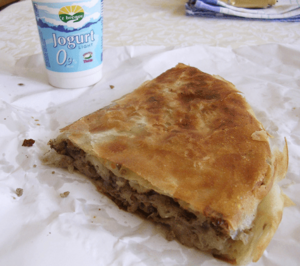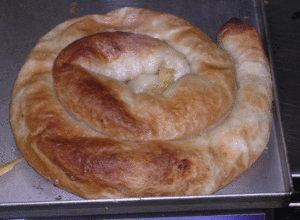Börek facts for kids
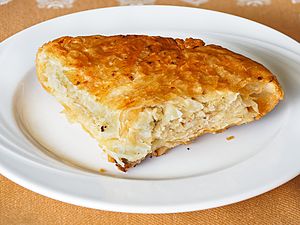
Meat borek
|
|
| Alternative names | Burek, börek, bourekas, boreg, byrek |
|---|---|
| Type | Savoury pie |
| Course | Tea pastry |
| Region or state | Many |
| Main ingredients | Flaky pastry (usually filo), various fillings |
| Variations | Meat, potatoes, leafy greens, cheese, eggplant, mushrooms |
Börek (pronounced "boh-rek") is a delicious family of pastries or pies. It's popular in the Middle East and the Balkans. This tasty treat is made from thin, flaky dough, often called filo. It can have many different fillings, like meat, cheese, spinach, or potatoes.
Börek can be made in a big pan and then cut into pieces. Or, it can be made as smaller, individual pastries. Most often, börek is baked, but some types can be fried. Sometimes, people sprinkle sesame or nigella seeds on top. You can enjoy börek hot or cold.
In the Balkan countries and Turkey, börek is often served with a yogurt drink called ayran or just plain yogurt. For Sephardic Jews, it's a tradition to eat bourekas for their Shabbat breakfast on Saturday mornings.
Contents
What is Börek?
Börek is a type of savory pastry. It's known for its thin, layered dough. This dough is often stretched very thin, almost like paper. The fillings inside can be salty or even sweet. Börek is a popular food for breakfast, snacks, or even light meals.
Where Does Börek Come From?
The name börek comes from the Turkish language. The word börek might come from an old Turkic word meaning "to twist." This makes sense because many börek types are twisted or rolled. Another idea is that it comes from a word meaning "kidney," but this is less likely.
Some historians think that börek might be related to a very old dish from the Byzantine Empire. This ancient dish was a layered pastry with cheese. It was similar to pies made in Ancient Greece and Ancient Rome.
Börek became a very important part of Ottoman cuisine. The Ottoman Empire was a large empire that included many of the places where börek is popular today. It's possible that different versions of börek were made by Turkish people in Central Asia even before they moved to Anatolia (modern-day Turkey).
Börek Around the World
Börek is loved in many countries that were once part of the Ottoman Empire. This includes countries in North Africa and across the Balkan Peninsula. It's also a special food for Mizrahi and Sephardic Jewish communities.
Turkish Börek Styles
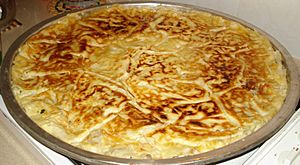
A tray of su böreği from Turkish cuisine
|
In Turkey, the word börek can change depending on its shape, what's inside, or where it's from. Here are some popular types:
| Name | What it's like |
|---|---|
| Su böreği | This means "water börek." Its dough sheets are briefly boiled, then layered with cheese and greens. It's brushed with butter and baked. |
| Sigara böreği | These are small, thin rolls, like cigarettes. They are filled with cheese, sausage, or potato and then deep-fried. |
| Paçanga böreği | This börek is made with yufka dough. It's filled with cheese, pastirma (cured meat), tomato, parsley, and pepper. It's fried and served hot. |
| Talaş böreği | These are small, square böreks. They are often filled with lamb cubes and green peas. The dough is starchy, making it puffy and crispy. |
| Kol böreği | This means "arm börek." It's prepared in long rolls, either rounded or straight. Fillings include minced meat, feta cheese, spinach, or potato. |
| Sarıyer böreği | This is a smaller, slightly richer version of "Kol böreği." It's named after Sarıyer, a district in Istanbul. |
| Gül böreği | This means "rose börek." It's rolled into small spirals that look like roses. |
| Çiğ börek | This is a half-moon shaped börek. It's filled with a thin layer of raw minced meat and onion. It's fried in oil and very popular in places with a Tatar community. |
| Töbörek | Another Tatar type, similar to çiğ börek, but it's baked instead of fried. |
| Laz böreği | This is a sweet börek! It's filled with muhallebi (a type of milk pudding or custard). It's served with powdered sugar on top. |
| Kürt Böreği | Similar to Laz böreği, but without the custard filling. It's also called sade (plain) börek and served with fine powdered sugar. |
Börek in the Balkans
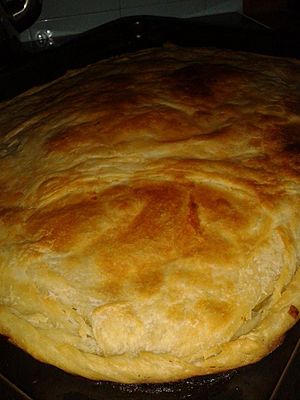
In the countries of the former Yugoslavia, burek is a very common dish. In Bosnia and Herzegovina, it's often called pita. This pastry is also popular in Croatia, Serbia, Albania, Kosovo, Montenegro, and North Macedonia. Burek is made with layers of dough and filling in a round pan. Traditionally, it can be empty (prazan), or filled with minced meat and onions, or cheese. Today, bakeries offer many fillings like cheese and spinach, apple, sour cherries, or potatoes. It's often eaten with a plain yogurt drink.
Zeljanica is a type of burek with spinach or chard. It's common throughout the Balkans.
Albanian and Kosovan Byrek
In Albania, this dish is called byrek. In Kosovo and some other areas, byrek is also known as "pite." Byrek is usually made with thin layers of dough rolled out by hand. You can find it as small, individual triangles from street vendors. It can also be made as one large byrek that is cut into pieces. Byrek can be served cold or hot.
Common fillings include cheese (especially gjizë, a salted cheese), ground meat and onions, spinach and eggs, or milk and eggs. It can also be made with tomato and onions, peppers and beans, potato, or sweet fillings like pumpkin, nettles, or kidney beans.
There are two main types of Albanian Byrek: house byrek (byrek shtëpie) and triangle byrek (byrek trekendësh). The triangle byrek is mostly sold as street food.
Lakror is another Albanian pie from southern Albania. It's sometimes called a type of byrek. Lakror is usually filled with greens or meats. Fli is a related dish from northern Albania and Kosovo. It has layers of flour and water batter, cream, and butter. It's traditionally baked over embers.
Bosnian Pita and Burek
In 2012, Lonely Planet featured Bosnian burek in their "The World's Best Street Food" book. In Bosnia and Herzegovina, burek is a meat-filled pastry. It's traditionally rolled in a spiral shape and cut into sections. If it's filled with cottage cheese, it's called sirnica. With spinach and cheese, it's zeljanica. With potatoes, it's krompiruša. All these are generally called pita.
Bulgarian and North Macedonian Byurek
The Bulgarian version of this pastry is called byurek. It's seen as a type of banitsa, which is a similar Bulgarian dish. Bulgarian byurek is a banitsa with sirene cheese, but it also has eggs added.
In Bulgaria, "byurek" can also mean other dishes made with cheese and eggs. For example, chushka byurek is a roasted pepper filled with cheese. Tikvichka byurek is made with squash and eggs.
Greek Boureki and Bougatsa
In Greece, boureki or bourekaki, and in Cyprus poureki, are small pastries. They are made with phyllo dough or other pastry crusts. Pastries in the börek family are also called pita (pie) in Greece, like tiropita (cheese pie) and spanakopita (spinach pie). Galaktoboureko is a sweet phyllo pastry with custard, common in Greece and Cyprus.
Bougatsa is a Greek type of borek. It has semolina custard, cheese, or minced meat filling between layers of phyllo. It's said to come from the city of Serres. This pastry art was brought by immigrants from Constantinople. It's most popular in Thessaloniki. On June 1, 2008, Serres made the world's largest puff pastry. It weighed 182.2 kg (402 lb) and was 20 meters (66 ft) long!
Serbian Burek History
The recipe for "round" burek was created in the Serbian town of Niš. In 1498, a famous Turkish baker named Mehmed Oğlu from Istanbul brought it there. From Niš, burek spread across the rest of Yugoslavia. Niš even hosts an annual burek competition and festival called Buregdžijada. In 2005, a huge 100 kg (220 lb) burek was made. It had a diameter of 2 meters (6.6 ft) and is thought to be the biggest burek ever made.
Slovenian Burek Today
In Slovenia, burek is a well-known and easy-to-find fast food. It's especially popular among students and in city nightlife. While many people enjoy it, it also has cultural links to its Balkan origins. It's not always seen as a traditional Slovenian dish.
Romanian and Moldovan Pies
In the Moldavian region, there's a dumpling-like food called burechiuşe. These are like ravioli, filled with mushrooms, and then boiled in soups like borscht. It's traditionally eaten on Christmas Eve.
In Romania, plăcintă is a type of phyllo-wrapped pie. The dough is often filled with cheese. In Dobruja, a region that was once part of Turkey, you can find Turkish influences. Plăcintă dobrogeană can be filled with cheese or minced meat and served with sheep yogurt. There's also Suberek, a deep-fried, half-moon shaped dough filled with cheese.
Börek in Other Countries
Algerian Bourek and Brik
In Algeria, this dish is called bourek. It's a roll of pastry filled with meat, onions, and spices. Bourek is a main appetizer in Algerian cuisine.
It's often served when guests visit, especially during Ramadan evenings. It usually comes with Algerian Chorba or Harira soup. Other types of bourek include chicken and onions, shrimp and béchamel sauce, or a vegetarian version with mashed potatoes and spinach.
Another Algerian type of Bourek is called Brik or Brika. It's a specialty from eastern Algeria, especially Annaba. It's made from a brik leaf (a thin pastry sheet). It's filled with mashed potatoes, minced meat, onions, cheese, and parsley. A raw egg is added on top, and it cooks when the brik is folded and fried in hot oil.
Armenian Byorek
In Armenia, byorek or borek is made of dough or filo dough. It's folded into triangles and filled with spinach, onions, and feta cheese, or ground beef.
Israeli Bourekas
Bourekas (Hebrew: בורקס) have been part of Sephardic Jewish cuisine for a long time. They became popular after many Sephardic Jews moved to the Ottoman Empire. The name "burekas" is the plural form of the original Balkan dish in Judaeo-Spanish.
Bourekas were brought to Israel by Sephardi immigrants from Turkey and the Balkans. Today, they are sold everywhere in bakeries and special market stalls.
Israeli Bourekas can have many different fillings. Meat is less common because of Jewish dietary laws, which say you shouldn't mix milk and meat. Many bourekas are made with Margarine-based dough instead of butter. This makes them Parve, meaning they can be eaten with any type of meal. The most popular fillings are salty cheese (like Feta), spinach, eggplant, and mashed potato. Other fillings include mushrooms, sweet potato, chickpeas, olives, and tomato sauce (called "burekas pizza"). Bourekas are often served as snacks at gatherings or meetings. You can also buy frozen bourekas in grocery stores to bake at home.
Libyan Brik
Brik is also a popular dish in Libya.
Saudi Arabian Burēk
In Saudi Arabia, Burēk (Arabic: بُريك) is usually made in the Hejaz region. It often looks like the Bosnian rolled burek, but can also come in other shapes. It's filled with minced meat or salty cheese and dill. It's usually served during the month of Ramadan, similar to samosas.
Tunisian Brik
In Tunisia, there's a type of brik (pronounced "BREEK"). It's a thin, crepe-like pastry around a filling, and it's usually deep fried. The most famous is the egg brik. It has a whole egg inside a triangular pastry pocket, along with chopped onion, tuna, harissa (a spicy paste), and parsley. The Tunisian brik is also very popular in Israel because of the large Tunisian Jewish population there. It's often filled with a raw egg and herbs or tuna, harissa, and olives. Sometimes, it's served inside a pita bread. This is also known as a boreeka.
See also
 In Spanish: Börek para niños
In Spanish: Börek para niños


